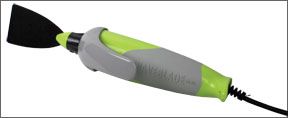
288

288
More and more boat bottoms are being coated with low-biocide and biocide-free antifouling as environmental regulations and boater eco-consciousness continue to evolve. As a result, those bottoms are being cleaned more frequently, and boat owners are seeking out tools that will make the job less work. Enter the new Waveblade, a submersible, vibrating power tool designed to tackle barnacles, mussels, and other stubborn growth without removing bottom paint or marring gelcoat.
Made by Wavecraft, the handheld Waveblade runs on 12-volt DC power fed via a 45-foot power cord and cigarette-lighter-style fused plug. The Waveblade is designed to remove fouling from fiberglass, wood, or metal, above or below the waterline. The oscillating head delivers a high-frequency resonance that vibrates the attached blade. (Interchangeable powder-coated steel and stainless-steel scrapers and flat chisels are available.)
Tempted by the thought of a tool that would make bottom cleaning easier without eating too much power (it draws about 3 amps), we asked a professional hull cleaner to give the Waveblade a whirl on our Cape Dory 25 test boat, which had the bad luck of being selected to test the first version of the eco-friendly Pacifica paint from Interlux (now replaced by the much-improved Pacifica Plus). The Waveblade had no problem quickly popping off mature barnacles without taking off bottom paint, but removing smaller barnacles left behind tell-tale white discs that had to be removed with a hand scraper. While the tool reduced the effort required to remove barnacles, the small blade required more passes than our tester’s favorite tool for big jobs, an extra-wide puttyknife/scraper.
The tool weighs just under 6 pounds; underwater, its heft was minimal. The cord was plenty long, but unlike the air hoses on our diver’s regulator, the power cord tended to sink and entangle his feet. As with most power tools, we’re certain that after a few uses, you can develop a technique that would get the barnacle bases off and keep the cord clear of feet.
The Waveblade is waranteed as waterproof to 15 feet deep, but it meets IP68 standard, which calls for continuous immersion to 60 feet. It retails for $400 (including a scraper, a chisel, gloves, goggles, and handy carrying bag) and comes with a one-year warranty.
Bottom line: Our initial thought was that Waveblade might appeal to the pro who cleans several hulls each day or the person who had let his hull become an artificial reef. However, our tester found that the inconvenience of the cord and the short maximum continuous operating time (30 minutes) offset any advantages for these purposes. The tool does give your arms a break, so if you have joint or strength issues that match your barnacle problem, then this might be an addition worth considering. As for us, we’ll stick with a $5 scraper—and plenty of elbow grease.

288
In our December 2007 review of small flashlights, we found that although the lights with LED bulbs were typically brighter and required less power than those with Xenon bulbs, the Xenons excelled in focusing the light—an important trait when you’re trying to spot a buoy. Since then, Streamlight Inc. has introduced the Sidewinder Tactical flashlight with C4 LED technology, a recent innovation that improves focusing and reflection of the LED’s beam. C4 LEDs are designed to give a brighter central spot while keeping the less-powerful outer spill flood.
We found the Streamlight Sidewinder Tactical ($58, models 14002 and 14003) to be ergonomically designed—large enough for comfortable gripping but light enough and small enough to be easily carried. It measures 4.65 inches tall by 2.34 inches wide and 1.08 inches thick, and it weighs only 5.02 ounces. The rectangular shape won’t roll away. The light gives long service from two AA batteries and features a choice of four light levels, a strobe function, and four colors of illumination: white (C4), green, red and blue.
Streamlight markets a smaller Sidewinder, the Compact Tactical ($53, models 14132 and 14133), that is powered by a 3-volt CR123 lithium battery, which is lighter but also cuts run time. Both Sidewinders offer a range of white-light intensity, from strong reading to floodlight (over 3,500 lux from 1½ feet), and they have night-vision red. The C4 LEDs produced impressive lux measurements that outperformed many flashlights and most of the headlamps (May 2008) we’ve tested.
Regular-issue items for some military groups, both models come with a removable belt clip, a hole for a lanyard, and are O-ring sealed for water resistance (it’s waterproof to 1 meter for 30 minutes). Testers’ favorite features of the flashlights are the 185-degree articulating head and ultra-simple controls—you can even change batteries in complete darkness.
Bottom line: Bright, tough, versatile, lightweight, and ergonomic, the Sidewinder deserves a place among our other recommended flashlights. Given all its great features, we’re surprised it doesn’t float, but you can’t have everything.







































